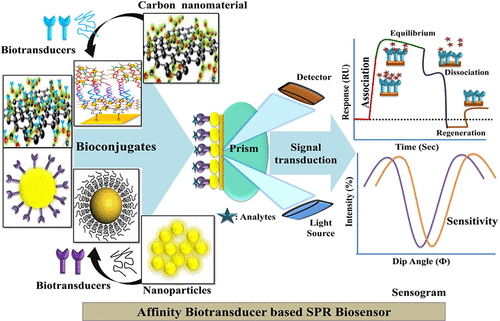当前位置:
X-MOL 学术
›
ACS Biomater. Sci. Eng.
›
论文详情
Our official English website, www.x-mol.net, welcomes your
feedback! (Note: you will need to create a separate account there.)
Affinity-Based Nanoarchitectured Biotransducer for Sensitivity Enhancement of Surface Plasmon Resonance Sensors for In Vitro Diagnosis: A Review
ACS Biomaterials Science & Engineering ( IF 5.4 ) Pub Date : 2020-12-05 , DOI: 10.1021/acsbiomaterials.0c01203 Sopan N. Nangare 1 , Pravin O. Patil 1
ACS Biomaterials Science & Engineering ( IF 5.4 ) Pub Date : 2020-12-05 , DOI: 10.1021/acsbiomaterials.0c01203 Sopan N. Nangare 1 , Pravin O. Patil 1
Affiliation

|
Despite the indisputable benefits and advancement of science, technology, and civilization, early diagnosis of healthcare is still a challenging field for the scientific fraternity. The detection of biomarkers is a crucial attribute of prognosis and diagnosis of disease. Out of numerous techniques, surface plasmon resonance (SPR) bestows countless benefits, including in situ, label-free, and real-time assessment, etc., which authorizes the analysis of molecular binding occurrences between biotransducers and biomarkers. In addition, SPR with low-molecular-weight biomarkers lacks selectivity and sensitivity, which ultimately affects binding kinetics. This, in turn, leads to the remarkable development and implementation of numerous selectivity and sensitivity enhancement methods. Among the various noticeable strategies, because of selectivity and sensitivity enrichment substrate for SPR biosensors, affinity-based nanoarchitectured biotransducers stand out as being the best substitute. The present review elaborates significant advances made in the research based on affinity biotransducers for in vitro diagnosis using SPR biosensors for biomarker sensing. Moreover, most recent trends and challenges in designing and application of nanoarchitectured affinity biotransducer-based SPR biosensors for detecting low-concentration biomarkers have been reviewed comprehensively. This present review may assist the scientific fraternity in designing an ultramodern novel SPR approach based on affinity biotransducers, along with improved selectivity and sensitivity of SPR biosensors for in vitro and real-time diagnostic applications.
中文翻译:

基于亲和力的纳米体系结构生物传感器,可提高表面等离振子共振传感器的体外诊断灵敏度:综述
尽管科学,技术和文明有无可争议的好处和进步,但医疗保健的早期诊断仍然是科学界的一个充满挑战的领域。生物标志物的检测是疾病预后和诊断的关键属性。在众多技术中,表面等离子体激元共振(SPR)带来了无数好处,包括原位,无标签和实时评估等方法,可以分析生物转导物和生物标志物之间的分子结合情况。此外,具有低分子量生物标志物的SPR缺乏选择性和敏感性,这最终会影响结合动力学。反过来,这导致了众多选择性和灵敏度增强方法的显着发展和实现。在各种引人注目的策略中,由于SPR生物传感器具有选择性和灵敏度高的底物,因此基于亲和力的纳米结构生物传感器是最佳替代品。本综述阐述了基于亲和力生物换能器的体外研究的重大进展使用SPR生物传感器进行生物标志物检测的诊断。而且,已经全面综述了用于检测低浓度生物标志物的基于纳米结构的亲和生物传感器的SPR生物传感器的设计和应用的最新趋势和挑战。这篇综述可以帮助科学界在设计基于亲和生物换能器的超现代新颖SPR方法的同时,提高SPR生物传感器在体外和实时诊断应用中的选择性和灵敏度。
更新日期:2021-01-11
中文翻译:

基于亲和力的纳米体系结构生物传感器,可提高表面等离振子共振传感器的体外诊断灵敏度:综述
尽管科学,技术和文明有无可争议的好处和进步,但医疗保健的早期诊断仍然是科学界的一个充满挑战的领域。生物标志物的检测是疾病预后和诊断的关键属性。在众多技术中,表面等离子体激元共振(SPR)带来了无数好处,包括原位,无标签和实时评估等方法,可以分析生物转导物和生物标志物之间的分子结合情况。此外,具有低分子量生物标志物的SPR缺乏选择性和敏感性,这最终会影响结合动力学。反过来,这导致了众多选择性和灵敏度增强方法的显着发展和实现。在各种引人注目的策略中,由于SPR生物传感器具有选择性和灵敏度高的底物,因此基于亲和力的纳米结构生物传感器是最佳替代品。本综述阐述了基于亲和力生物换能器的体外研究的重大进展使用SPR生物传感器进行生物标志物检测的诊断。而且,已经全面综述了用于检测低浓度生物标志物的基于纳米结构的亲和生物传感器的SPR生物传感器的设计和应用的最新趋势和挑战。这篇综述可以帮助科学界在设计基于亲和生物换能器的超现代新颖SPR方法的同时,提高SPR生物传感器在体外和实时诊断应用中的选择性和灵敏度。









































 京公网安备 11010802027423号
京公网安备 11010802027423号